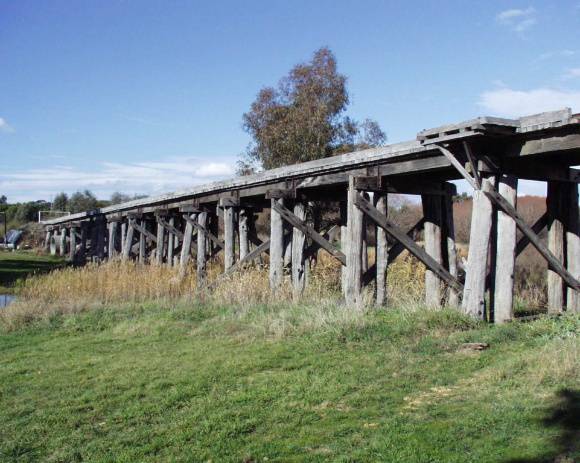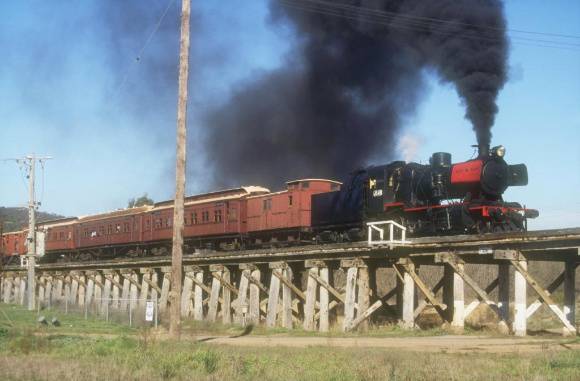| Back to search results » | Back to search page » |
|
Winters Flat Bridge
Other NameCampbells Creek Railway Bridge LocationParallel to Elizabeth Street, Castlemaine-Maldon Railway, south of Castlemaine, CASTLEMAINE VIC 3450 - Property No B6955
File NumberB6955LevelState |
|
Statement of Significance
The Winters Flat bridge is scientifically, historically and aesthetically significant at the state level.
The bridge is one of the oldest timber bridges built by the Victorian Railways to survive intact and demonstrates more about the adaptability and structural evolution of timber railway bridges of a medium height than has been documented for any other bridge built by the Victorian Railways with 15 feet spans because:-
* The structural history for this bridge as recorded by the early bridge inspectors is one of the most complete in the PTC bridge maintenance file for a bridge constructed with cast iron caps;
* The diversity of structural detail found in the bridge today. Of special interest are the types of pier it demonstrates (2-pile, 2-pile with stay piles, 5-pile pier, 3-pile with stay piles), and the rare sequence of stages in the conversion of 2-pile piers into 4-pile piers illustrated by the portion of the bridge over Langslow Street. Very rare elements contained in the superstructure are pipe ferrules between the beams, and the 1920's style joints in both gravel beams and runners.
The Winter's Flat bridge played a major role in maintaining the railway link between Maldon and Castlemaine. Although an insignificant branch line by Victorian standards, the construction of the Maldon line in 1884 enhanced the quality of life for the people of Maldon and the surrounding district by increasing travel opportunities and lowering transportation costs, and remained the dominant mode of transportation in the area for over 60 years.
It has been a prominent structue in the Winter's flat area since 1884. The visually striking feature of the Winter's flat bridge is its long length and relatively uniform pier height, within which the complex repetitive texture of a timber pile bridge is clearly demonstrated. It is visible from the Pyrenees Highway, and is readily accessible to the public along Langslow Street which passes under the Maldon end of the bridge.
No. 1 bridge is one of a diverse series of six timber bridges on the Maldon line that, together with an original 1884 iron girder bridge, are recognised to be of state significance as the most representative sequence of nineteenth century branch line bridges to survive intact in Victoria.
The significance of the bridge is enhanced by its presence on the short, 10 mile long, heritage rich Maldon branch line. Built in 1884 to service the gold mining town of Maldon, the 10 mile branch line terminated at Maldon. Even when the railway was extended a further 10 miles, Maldon station retained the characteristics of a small terminal station, with all trains arriving and departing at the same end. As the gold industry went into decline, so did the township of Maldon and its railway. The early insignificance of the railway resulted in vurtually no modernisation of the line or its infrastructure. When the line closed in 1976 its major items of outstanding heritage significance combined with its short length resulted in the Maldon line being selected for restoration and preservation as a working museum by a group of railway enthusiasts. A few weeks after the line closed the Castlemaine and Maldon Railway Preservation Society was formed and most of the heritage assets of the railway were reserved for preservation, including its outstanding collection of small to medium sized timber bridges.
Today half of the Castlemaine to Maldon railway, now marketed as the "Victorian Goldfields Railway", has been restored and every week tourists experience the historic railway items and heritage classified structures at the Maldon end of the line in the context of an operating 'steam-era' railway museum. When the second half of the Maldon line is restored, No1 bridge will be the longest all timber bridge built by the Victorian Railways still in railway service, and its intrinsic heritage significance will be maintained and enhance as steam trains once again carry people over Campbell's Creek, providing tourists with interesting visual and photographic opportunities while demonstrating the dominant role timber bridge and steam railway technologies once played in the transportation needs of Victoria.
Classified: 10/11/1998
Group
Transport - Rail
Category
Railway Bridge/ Viaduct






